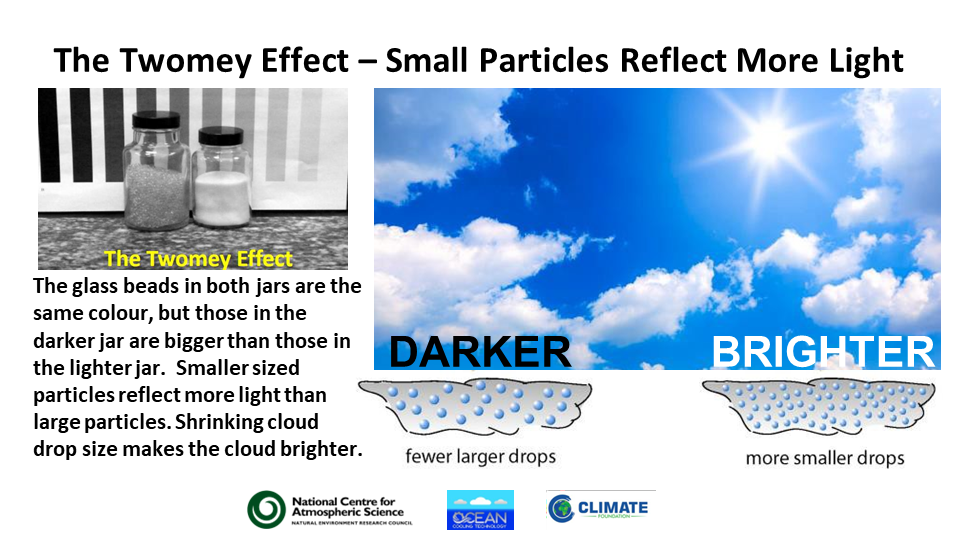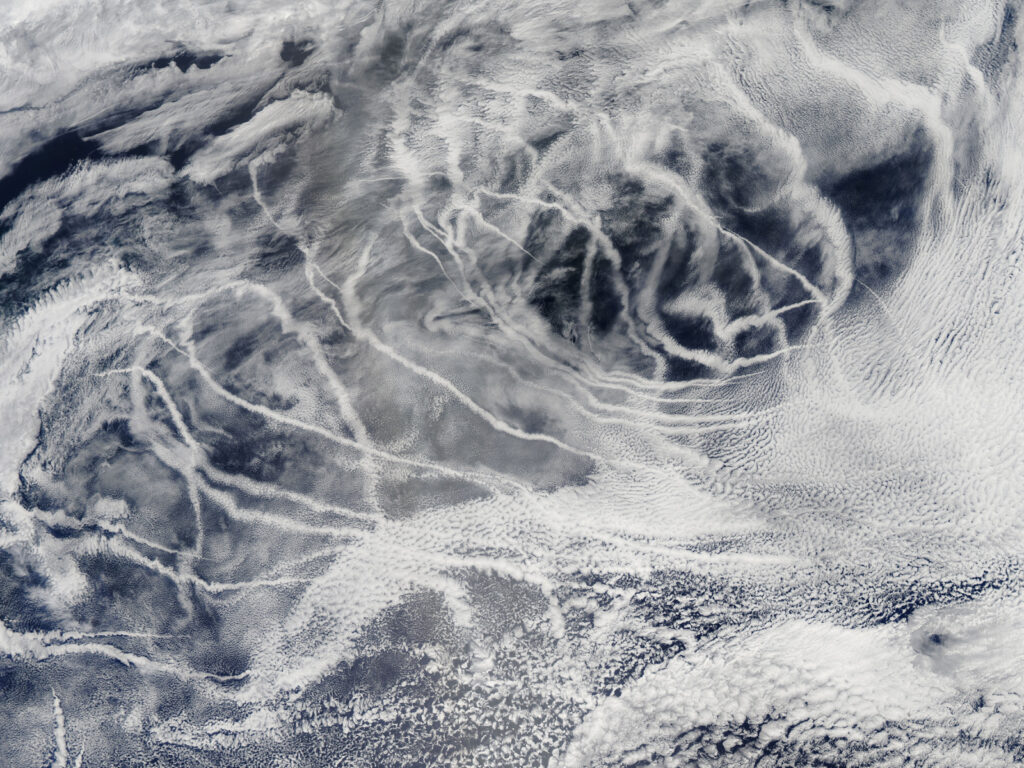Reflecting Sunlight to Cool the Ocean Surface and Reduce Global Warming
Welcome to Rebrighten.org. Our mission is to reverse climate disruption and regenerate a healthy climate.
We promote urgent action to rebrighten and cool the Earth by reflecting more sunlight, primarily using Marine Cloud Rebrightening (MCRB), alongside ongoing efforts to bring emissions to zero and remove greenhouse gases from the atmosphere.
As a not-for-profit organization, Rebrighten.org is dedicated to researching, promoting, and deploying MCRB as a rapid, effective, and safe method to reverse global warming. We aim to raise the necessary funds to demonstrate the viability of MCRB, complementing broader efforts to mitigate warming by reducing and removing greenhouse gases.
Why is Marine Cloud Rebrightening So Important?
- Marine Cloud Re-brightening (MCRB) is potentially the first feasible way to start cooling the planet by reflecting more sunlight back to space.
- MCRB would use Marine Cloud Brightening (MCB) technology developed by John Latham and Stephen Salter for the restoration of the Earth’s reflectance.
- Deployment would help slow global temperature rise, refreeze the poles and mitigate extreme weather such as hurricanes/ typhoons, fires, droughts, heatwaves and floods.
- Sea salt sprayed into the lower atmosphere in targeted areas is expected to prove a harmless way to reverse global warming.
- MCRB has potential to reverse sea level rise with benefit to cost ratio estimated at 50,000 to 1.
The following video explains more about this vital work to create a brighter, safer future for our planet and humanity:
Why Does the Earth Need Rebrightening Now?
Over the past 20 years, our planet has become dimmer and duller. NASA satellites have found that planetary brightness (albedo) is now falling by more than 1% per decade. The Earth is going through rapid decline in its natural reflectance – essential for regulating temperature. Factors such as the darkening of the Greenland Ice Sheet, the loss of Arctic and Antarctic sea ice, and the reduced aerosol cooling effect from recent changes to shipping fuels, have accelerated this dangerous trend. Loss of aerosols has resulted in a notable reduction in marine clouds and is widely thought to be a main cause of the severe heat waves in 2023. Together with the increase of greenhouse gases that are trapping heat in Earth’s systems, the loss of planetary brightness is edging us perilously close to catastrophic climate tipping points. Global efforts to achieve ‘Net Zero’ emissions cannot stop us from crossing the critical warming thresholds of 1.5°C and 2°C.
At Rebrighten.org, we believe that the time for urgent action is now. Dr James Hansen, a leading authority on climate science, endorses Marine Cloud Rebrightening as “the most innocuous” method to prevent dangerous planetary heating and sea level rise. He states, “Temporary solar radiation management will probably be needed, such as via purposeful injection of atmospheric aerosols…The most innocuous aerosols may be fine salty droplets extracted from the ocean and sprayed into the air by autonomous sailboats. This approach has been discussed for potential use on a global scale, but it needs research into potential unintended effects. This decade may be our last chance to develop the knowledge, technical capability, and political will for actions needed to save global coastal regions from long-term inundation” (Hansen et al, Global Warming In The Pipeline, Oxford, 2023).
Marine Cloud ReBrightening (MCRB) means restoring marine clouds to pre-industrial levels. MCRB offers a feasible way to halt further warming by increasing the Earth’s reflectance and to reflect more sunlight into space as in previous centuries. Restoring a mere 0.6% of planetary reflectivity can offset all the warming since pre-industrial times.
Twomey, Latham and Salter – 50 Years of MCB Research
Marine Cloud Brightening (MCB) technology has been recognised for 50 years as a simple way to cool the oceans. It relies on the ‘Twomey Effect’, from its discoverer Dr Sean Twomey, who showed that clouds with smaller drops reflect more sunlight and are brighter than clouds with larger drops. The picture below shows a demonstration of this effect using glass beads – where the jar with larger glass beads appears much darker than the jar of smaller glass beads (even though the beads are all made of the same substance and are the same colour).

Sean Twomey found that the clouds formed in the wake of plumes of smoke from ship funnels were inadvertently reflecting a lot of sunlight back to space, helping shield the oceans from the warming effect of solar radiation. This was due to the tiny sulfate particles from the smoke emitted from the ship funnels becoming ‘condensation nuclei’ and allowing tiny water droplets to form bright clouds, as shown in the photo below:

Dr John Latham then showed that natural seasalt derived from seawater sprayed above the oceans could also act as an ideal condensation nuclei – with the optimal cloud drop size for marine cloud brightening being smaller than one micron. Dr Stephen Salter has since been developing the necessary engineering hardware design for a fleet of remote controlled, wind powered hydrofoil boats to spray the fine seawater droplets into the air over the oceans necessary to implement this vital technology.
Study results show MCB can deliver a significant increase in albedo (ability of the earth to reflect sunlight back to space rather than absorb it as heat). As a result, estimated global cooling with MCB deployed widely, is enough to balance the warming effects of a doubling of pre-industrial CO2 level (Latham 2012).
Because the energy reflected back to space by a tiny water droplet, formed as a MCRB is millions of times more than the energy required to form the droplet (by the seawater spray method) it would be an extremely cost effective method of cooling the oceans – and slowing (or even halting) global warming.
MCB can therefore be a gamechanger for climate policy, preventing dangerous warming while emissions reductions and CO2 removal ramp up over the coming decades.
Sea salt added to clouds, regionally and seasonally to achieve a cooling effect as required, is extremely safe and beneficial for combating climate change (in conjunction with carbon reduction and removal).
We have the opportunity to bring governments and communities with us, through effective messaging and consultation about MCRB as an effective climate response.
Hurricane Abatement by MCB

Hurricanes and floods caused $120 billion in insurance losses in 2022, according to reinsurer Munich Re. MCB could significantly reduce this loss of property and life by reducing sea surface temperature in advance of the hurricane season. Deployment to cool the Atlantic Ocean hurricane nursery shown in the above diagram, could cut intensity of hurricanes from Category 5 to Category 2 or 3, greatly reducing the damage and loss of life they cause.
MCB Reducing Earth’s Energy Imbalance to Restore Our Climate
The total extra heating due to atmospheric greenhouse gas pollution is approximately 1.7w/m2. The total energy from incoming sunlight is 340W/m2 . Therefore this energy imbalance causing global warming is approximately 0.5% of incoming sunlight being trapped by greenhouse gases. It follows that if we can increase the world’s average reflectivity by just 0.5%, we can counteract all global warming and resolve the problem of earth’s energy imbalance (EEI), the main proximate cause of climate change. There is strong evidence this can be achieved safely with marine cloud brightening technology, applied in areas of low level marine clouds as shown in studies such as Stern et al (2018).

Support Our MCRB Research Today :
We seek to raise USD $5 million to implement our proposal to prove the feasibility of MCB as a way to cool and re-brighten the planet, alongside broader existing efforts to mitigate warming by cutting and removing greenhouse gases. Help us create a brighter, safer future for the planet & humanity by supporting this crucial project. See the Donate page for project components.

